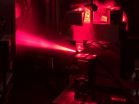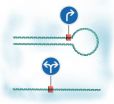(Press-News.org) Quantum dots are nanostructures of semiconducting materials that behave a lot like single atoms and are very easy to produce. Given their special properties, researchers see huge potential for quantum dots in technological applications. Before this can happen, however, we need a better understanding of how the electrons "trapped" inside them behave. Dresden physicists have recently observed how electrons in individual quantum dots absorb energy and emit it again as light. Their results were recently published in the journal "Nano Letters".
Quantum dots look like miniscule pyramids. Inside each of these nano-pyramids are always only one or two electrons that essentially "feel" the constricting walls around them and are therefore tightly constrained in their mobility. Scientists from Helmholtz-Zentrum Dresden-Rossendorf (HZDR), TU Dresden and the Leibniz Institute for solid State and Materials Research Dresden (IFW) have now studied the special energy states of the electrons trapped inside individual quantum dots.
Sharp energy levels
The behaviour of electrons in a material essentially determines its properties. Being spatially constrained in all three spatial dimensions, electrons inside a nano-pyramid can only occupy very specific energy levels – which is why quantum dots are also called "artificial atoms". Where these energy levels lie depends on the chemical composition of the semiconductor material as well as the size of the nano-pyramid. "These sharply defined energy levels are exploited, for example, in highly energy-efficient lasers based on quantum dots. The light is produced when an electron drops from a higher energy level into a lower one. The energy difference between the two levels determines the colour of the light," Dr. Stephan Winnerl of HZDR explains.
Seeing electrons inside individual quantum dots
The researchers in Dresden working with Dr. Winnerl were recently the first to succeed in scanning transitions between energy levels in single quantum dots using infrared light. Although, they could only do this after overcoming a certain hurdle: While the pyramids of indium arsenide or indium gallium arsenide form spontaneously during a specific mode of crystal growth, their size varies within a certain range. Studying them with infrared light, for example, one obtains blurred signals because electrons in different sized pyramids respond to different infrared energies. This is why it is so important to obtain a detailed view of the electrons trapped inside a single quantum dot.
The scientists approached this task with the special method of scanning near-field microscopy. Laser light is shone onto a metallic tip less than 100 nanometers thick, which strongly collimates the light to a hundred times smaller than the wavelength of light, which is the spatial resolution limit for "conventional" optics using lenses and mirrors. By focusing this collimated light precisely onto one pyramid, energy is donated to the electrons, thereby exciting them to a higher energy level. This energy transfer can be measured by watching the infrared light scattered from the tip in this process. While near-field microscopy involves major signal losses, the light beam is still strong enough to excite the electrons inside a nano-pyramid. The method is also so sensitive that it can create a nanoscale image in which the one or two electrons inside a quantum dot stand out in clear contrast. In this fashion, Stephan Winnerl and his colleagues from HZDR, plus physicists from TU and IFW Dresden, studied the behaviour of electrons inside a quantum dot in great detail, thereby contributing towards our understanding of them.
Infrared light from the free electron laser
The infrared light used in the experiments came from the free electron laser at HZDR. This special laser is an ideal infrared radiation source for such experiments because the energy of its light can be adjusted to precisely match the energy level inside the quantum dots. The laser also delivers such intense radiation that it more than makes up for the unavoidable losses inherent to the method.
"Next, we intend to reveal the behaviour of electrons inside quantum dots at lower temperatures," Dr. Winnerl says. "From these experiments, we hope to gain even more precise insights into the confined behavior of these electrons. In particular, we want to gain a much better understanding of how the electrons interact with one another as well as with the vibrations of the crystal lattice." Thanks to its intense laser flashes in a broad, freely selectable spectral range, the free electron laser offers ideal conditions for the method of near-field microscopy in Dresden, which benefits particularly from the close collaboration with Prof. Lukas Eng of TU Dresden in the scope of DRESDEN-concept.
INFORMATION:
Electrons confined inside nano-pyramids
Dresden physicists have recently observed how electrons in individual quantum dots absorb energy and emit it again as light
2012-09-28
ELSE PRESS RELEASES FROM THIS DATE:
Loop the loop, DNA style
2012-09-28
In certain toy racecar tracks, sneaky players can flip a switch, trapping their opponents' vehicles in a loop of track. Cells employ a less subtle approach: they change the track's layout. In a study published online today in Science, scientists at the European Molecular Biology Laboratory (EMBL) and Oxford University discovered that, by forming or undoing gene loops, cells manipulate the path of the transcription machinery – which reads out instructions from DNA – controlling whether it moves along the genetic material in one direction or two.
"We found that gene loops ...
Nanosciences: All systems go at the biofactory
2012-09-28
In order to assemble novel biomolecular machines, individual protein molecules must be installed at their site of operation with nanometer precision. LMU researchers have now found a way to do just that. Green light on protein assembly!
The finely honed tip of the atomic force microscope (AFM) allows one to pick up single biomolecules and deposit them elsewhere with nanometer accuracy. The technique is referred to as Single-Molecule Cut & Paste (SMC&P), and was developed by the research group led by LMU physicist Professor Hermann Gaub. In its initial form, it was only ...
What makes surgeons happy?
2012-09-28
TORONTO, Sept. 28, 2012—Lack of control over operating rooms and other resources as well as a lack of work-life balance are among the main reasons general surgeons may be dissatisfied with their jobs, a new study has found.
The study was led by Dr. Najma Ahmed, a trauma surgeon at St. Michael's Hospital, at a time when both the Association of American Medical Colleges and the Canadian Medical Association have reported a decline in the number of general surgeons due to low recruitment, poor retention and early retirement.
Dr. Ahmed said that since the general surgery ...
Study ties early menopause to heart attack, stroke
2012-09-28
Women who experience early menopause are more likely to have a heart attack or stroke than women whose menopause occurs at a later age, according to a new study by Melissa Wellons, M.D., assistant professor of Medicine in the Vanderbilt Division of Diabetes, Endocrinology and Metabolism.
Wellons conducted the research while working at the University of Alabama-Birmingham and it is published in the current issue of Menopause: The Journal of The North American Menopause Society.
She said the study is especially important because cardiovascular disease is the leading cause ...
When your eyes tell your hands what to think
2012-09-28
EVANSTON, Ill. --- You've probably never given much thought to the fact that picking up your cup of morning coffee presents your brain with a set of complex decisions. You need to decide how to aim your hand, grasp the handle and raise the cup to your mouth, all without spilling the contents on your lap.
A new Northwestern University study shows that, not only does your brain handle such complex decisions for you, it also hides information from you about how those decisions are made.
"Our study gives a salient example," said Yangqing 'Lucie' Xu, lead author of the ...
Study reveals wide discrepancy in multidrug surveillance among intensive care units
2012-09-28
Washington, DC, September 28, 2012 – Screening practices for multidrug-resistant organisms (MDROs) in intensive care units (ICUs) vary widely from hospital to hospital, according to a new study published in the October issue of the American Journal of Infection Control, the official publication of the Association for Professionals in Infection Control and Epidemiology (APIC).
The P-NICE interdisciplinary research team from the Columbia University School of Nursing collected and analyzed survey responses from the infection preventionists (IPs) of 250 hospitals that participated ...
Language and perception – Insights from Psychological Science
2012-09-28
New research published in Psychological Science, a journal of the Association for Psychological Science, examines the nuanced relationship between language and different types of perception.
Bilingual Infants Can Tell Unfamiliar Languages Apart
Speaking more than one language can improve our ability to control our behavior and focus our attention, recent research has shown. But are there any advantages for bilingual children before they can speak in full sentences? We know that bilingual children can tell if a person is speaking one of their native languages or the ...
Hospital observation units could save the health care system $3.1 billion
2012-09-28
Boston, MA – Previous research has shown that observation units in a hospital can be an efficient way to care for certain patients, but only about one-third of hospitals in the United States have such units. Now, researchers at Brigham and Women's Hospital (BWH) estimate that maximizing the potential of an observation unit in a hospital could result in $4.6 million in savings annually for the hospital and $3.1 billion in overall savings for the health care system in the United States. These findings are published online by Health Affairs and will also appear in the journal's ...
Penn immunologists find a molecule that puts the brakes on inflammation
2012-09-28
PHILADELPHIA — We couldn't live without our immune systems, always tuned to detect and eradicate invading pathogens and particles. But sometimes the immune response goes overboard, triggering autoimmune diseases like lupus, asthma or inflammatory bowel disease.
A new study led by University of Pennsylvania researchers has now identified a crucial signaling molecule involved in counterbalancing the immune system attack.
"The immune response is like driving a car," said Christopher Hunter, professor and chair in the Department of Pathobiology in Penn's School of Veterinary ...
Venice Lagoon research indicates rapid climate change in coastal regions
2012-09-28
Research undertaken by the University of Southampton and its associates in Venice has revealed that the sea surface temperature (SST) in coastal regions is rising as much as ten times faster than the global average of 0.13 degrees per decade.
Researchers believe that this is partly as a result of a process known as the 'urban heat island effect'; where regions experiencing rapid industrial and urban expansion produce vast amounts of heat, making the area warmer than its surroundings.
Professor Carl Amos of Ocean and Earth Sciences at the University of Southampton, ...
LAST 30 PRESS RELEASES:
Scalable and healable gradient textiles for multi‑scenario radiative cooling via bicomponent blow spinning
Research shows informed traders never let a good climate crisis go to waste
Intelligent XGBoost framework enhances asphalt pavement skid resistance assessment
Dual-function biomaterials for postoperative osteosarcoma: Tumor suppression and bone regeneration
New framework reveals where transport emissions concentrate in Singapore
NTP-enhanced lattice oxygen activation in Ce-Co catalysts for low-temperature soot combustion
Synergistic interface engineering in Cu-Zn-Ce catalysts for efficient CO2 hydrogenation to methanol
COVID-19 leaves a lasting mark on the human brain
Scientists use ultrasound to soften and treat cancer tumors without damaging healthy tissue
Community swimming program for Black youth boosts skills, sense of belonging, study finds
Specific depressive symptoms in midlife linked to increased dementia risk
An ‘illuminating’ design sheds light on cholesterol
Who is more likely to get long COVID?
Study showcases resilience and rapid growth of “living rocks”
Naval Research Lab diver earns Office of Naval Research 2025 Sailor of the Year
New Mayo-led study establishes practical definition for rapidly progressive dementia
Fossil fuel industry’s “climate false solutions” reinforce its power and aggravate environmental injustice
Researchers reveal bias in a widely used measure of algorithm performance
Alcohol causes cancer. A study from IOCB Prague confirms damage to DNA and shows how cells defend against it
Hidden viruses in wastewater treatment may shape public health risks, study finds
Unlock the power of nature: how biomass can transform climate mitigation
Biochar reshapes hidden soil microbes that capture carbon dioxide in farmland
Reducing saturated fat intake shows mortality benefit, but only in high-risk individuals
Manta rays create mobile ecosystems, study finds
Study: Mixed results in using lipoic acid to treat progressive multiple sclerosis
Norbert Holtkamp appointed director of Fermi National Accelerator Laboratory
New agentic AI platform accelerates advanced optics design
Biologists discover neurons use physical signals — not electricity — to stabilize communication
Researchers discover that a hormone can access the brain by hitchhiking
University of Oklahoma researcher awarded funding to pursue AI-powered material design
[Press-News.org] Electrons confined inside nano-pyramidsDresden physicists have recently observed how electrons in individual quantum dots absorb energy and emit it again as light


